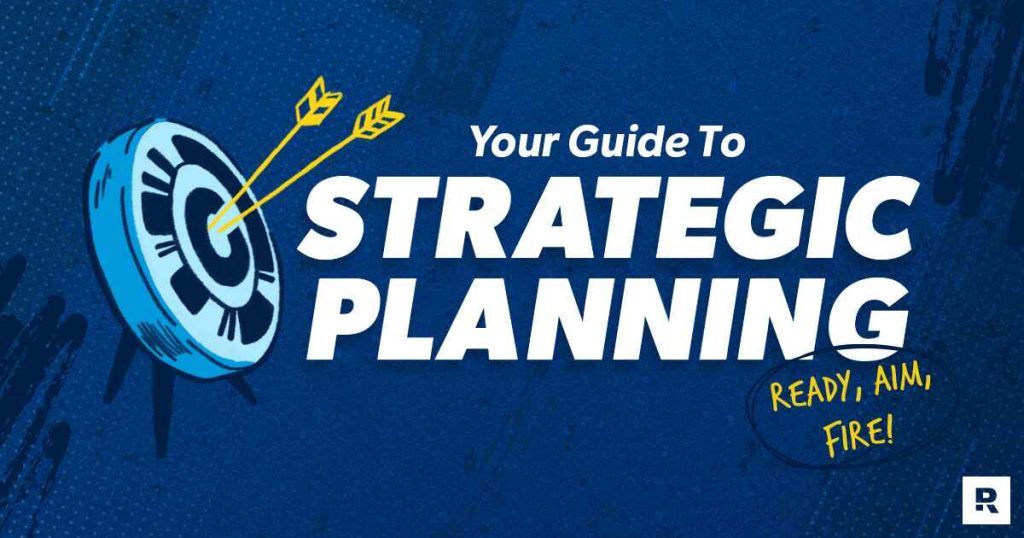What if you had access to a turbo boost with the power to turn your business into a booming success story? You do! It’s a process every successful company uses to gain momentum—strategic planning. If that sounds like a lot of crunching numbers and analyzing trends, you’re right. But that’s not all. A good strategic planning process allows you to finally stop flying by the seat of your pants because you’ve taken the time to see your business clearly. It lets you see where you’re winning, where you’re losing, and where you’re primed for growth. Even the most hard-charging leader can get behind a goal like that.
The truth is, if you want to move your business forward, you need to learn strategic business planning. But before we get into the specifics of how to develop a strategic plan, let’s take a look at the definition of strategic planning and why it’s important for your business.
What Is Strategic Planning?
If you’re a people person and love to collaborate, you’ll be happy to know what strategic planning isn’t. It isn’t something you do during a retreat on a mountaintop with a bunch of bean counters who talk a good business game but never execute, as in ready, aim, aim . . . but never fire.
Effective strategic planning is a team effort. It’s a systematic, action-oriented process for coming up with your . . . wait for it . . . strategic plan. That’s right, you do strategic planning to come up with a strategic plan to grow your business. We also call it your desired future. Once you identify the future you want, you set goals, decide how to reach them, and give your team the resources to achieve them, aka ready, aim, fire!
Does that mean strategic business planning involves looking at numbers, projections and market trends? Abso-freaking-lutely. But not just for the sake of stockpiling information. Ultimately, you’ll use all the facts, figures, fussing and discussing from your strategic planning meetings with your leadership team to set big goals and supercharge your work.
You only need to create a strategic plan once a year—during a day dedicated only to planning for the year ahead. But it’s a good idea to add in quarterly planning meetings to review your progress, refine your goals, and decide what you’ll focus on most over the next three months.
Related article: What Is a Key Performance Indicator?
Why Is a Strategic Plan Important?
To understand the power of strategic planning, we’ve pulled an example of a well-executed, large-scale strategic plan from the pages of history. On the beaches of Normandy, France, in June 1944, World War II allied armies brought together their land, air and sea forces in the largest amphibious invasion in military history. They worked out a blueprint for how to defeat German Nazi forces. Less than a year later, Germany surrendered. What drove the allied troops’ success? A unified strategic plan executed with focused intensity over time.
Related articles:
Building Unstoppable Momentum
Cash Flow vs. Profit: Which Is More Important?
The fate of the free world may not depend on the success of your business, but your fate depends on it. And this principle is still true: Success doesn’t happen by accident. To win in business and make a positive, long-term impact, you need a strategic plan that gets all the important areas of your business on the same page and focused on the same things.
Here’s why a strategic plan is important:
- It moves you from dreaming about making an impact to doing it.
- It unifies your team toward a common desired future.
- It guides you through unpredictable business waters with purpose and precision.
- It fires you up and energizes your team with fresh ideas, creative problem-solving and a road map to achieve big goals.
- It makes your business stronger.
Related articles:
Vision Casting: 7 Reasons Why It Matters
What Is a Vision Statement and How Do I Write One?
How to Make an Effective Strategic Plan
Let’s get planning, right? We’re with you! So let’s walk through how to develop your strategic plan. We’ll refer to it as your desired future and add in some other terms that work alongside it: desired future statement, defining objectives and key results.
Your desired future statement is just that—a focused statement that guides your business decisions for the year. Nailing it, along with the defining objectives that will help you achieve it, is critical to knowing where you’re headed and what winning looks like for your company (your key results).
Here’s a visual for how your key results and defining objective work together toward your desired future statement.
6 Steps to Create Your Desired Future
Now, on to some strategic planning tips. Creating your desired future isn’t an exercise to do alone—so be sure to involve your key leaders as you work through the steps below.
Step 1: Brainstorm.
In your strategic planning meeting, brainstorm your desired future by asking this question: Where do we want our business to go in the next 12 months?
We highly recommend using a facilitator to guide your meeting. Have them add everyone’s ideas to a whiteboard or paste your sticky notes all over a wall for discussion. Every idea is worth noting, so list them all—don’t stop the creative flow.
Have the facilitator sort the ideas into similar topics to make them easier to work through.
Step 2: Narrow the options.
Now you’re ready to talk about all the ideas and weed out the ones you’re not going to focus on this year.
Narrow your list to three to five ideas to consider for this year. Talk them out, discuss them—maybe even argue—until you land on what you’re going to focus on for the next 12 months.
Remember: You’ll create a desired future statement just once a year during your annual planning meeting. Then you’ll meet quarterly to assess your progress and adjust your goals as necessary.
Step 3: Create your desired future statement.
Once you know what you’re going after, turn your area of focus into a concise desired future statement. EntreLeadership uses this formula to help thousands of small businesses craft their statements:
By [DATE], we will [CREATE OR DO THIS], resulting in [THIS].
Here’s an example: By December 2025, we will launch our second location in Tampa, Florida, resulting in a $1.5 million increase in annual revenue.
Clear. Simple. Effective. A desired future statement like this is easy to communicate to your team, and that makes it a powerful rallying point for your whole company.
Step 4: Create your defining objectives.
Below your statement, you’ll add your defining objectives. These elements lay out the plan for how you’ll reach your desired future. Your defining objectives are three to six benchmarks that answer the question, “What must be true to reach our desired future?”
Step 5: Choose an owner for each objective.
Assign a point person for each objective. The owner isn’t necessarily responsible for doing the work. But they are responsible for adding specific key results, leading the team to meet them, and reporting on progress. Here’s an example:
Defining objective: Flood the marketing funnel with new customer leads.
Owner: Marketing Team
Key results:
- Increase top of funnel impressions by 5%.
- Increase marketing email list by 10%.
- Develop and implement a fan-activation strategy.
Step 6: Track your progress weekly with your leadership team.
During weekly leadership meetings, you and your leaders will track progress toward your desired future. Make sure you all agree on what data owners should use to track their progress. For example, the owner of increasing your email list should report each week on how many new emails they’ve captured, how many have unsubscribed from the list, and the net gain or loss. Be sure your objective owners have the support they need to stay on track with their key results.
Pro tip: Use a green, yellow or red symbol to easily show your progress status toward your desired future (green = on pace; yellow = slightly off pace; red = will not meet the goal at the current pace).
By checking your progress regularly and giving your team the support they need, you’ll stay on track to reach your goals.
Related article: 7 Keys to Developing Leaders in Your Small Business
Strategic Planning Frequently Asked Questions
Now that you have the steps for strategic planning, aka setting your desired future, let’s go over some common questions that might pop up as you dive into your next strategic planning session. These FAQs will help you feel even more prepared.
Where should you do your strategic business planning?
How often should you do strategic planning?
- Start with one annual planning session.
- Once you have an annual planning meeting under your belt, follow it up with quarterly meetings to review your progress.
Who should be involved in creating the strategic plan for your business?
- Every member of your core leadership team must be all in.
- Don’t have a leadership team yet? That’s okay. Set aside time anyway to work on your strategic plan. Also consider inviting a few top-performing team members who are aligned with your business values and have leadership potential.
Get Ready to Lead Your First Strategic Business Planning Session
Now that you know the what, why, and how of planning your desired future, it’s time to hold your first session and let the ideas flow.
Using the EntreLeadership System will help you focus on the right things at the right time to grow your business. It’s the system Dave Ramsey and the EntreLeadership team developed that’s helped scale Ramsey Solutions into a $250 million business and national brand. It can help you move toward the future you desire too.
Read the full article here










